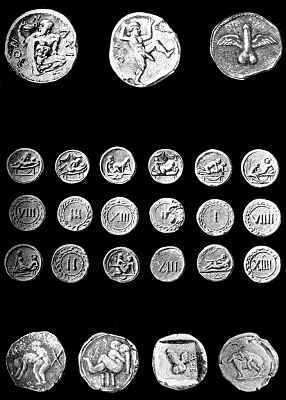 | ||
A spintria (plural, spintriae) is a small bronze or brass Roman token, possibly for use in brothels, although none of the literature on the spintriae contains any evidence to to support this assertion. The tokens usually depict on the obverse a motif of sexual acts or symbols and a numeral in the range I - XVI on the reverse.
Contents
Name
Spintria was used by Suetonius for young male prostitutes, from Greek σφιγκτήρ (sphinktḗr, [anal] sphincter). In the 16th century, the name passed from the ancient sense of the persons committing outrageous acts (or the place where outrageous acts occurred, such as Tiberius's gardens on the isle of Capri) to the tokens themselves. Bette Talvacchia identifies the first usage of the term spintriae to refer to the tokens occurs in Sebastiano Errizo's 1559 treatise, Discourse Concerning Ancient Medals (Sopra le Medaglie Antiche, Venice, 1559).
Use
Some scholars, following Friedlander's (1886) suggestion that the tokens were used "auf die man in Bordelle Einlass erheilt" ("to obtain entry to brothels") have argued that spintriae were used to pay prostitutes, although none offer any supporting evidence. Buttrey is dismissive of the brothel token idea, asserting "there is no evidence for any of this" (Buttrey 1973, p. 53). Currently, only Simonetta and Riva are supporters of the brothel token hypothesis, which is also popular with the media (see Duggan 2016); other scholars pursue alternate lines of enquiry (Buttrey; Campana; Duggan; Fishburn; etc). Under Caracalla, an equestrian was sentenced to death for bringing a coin with the emperor's likeness into a brothel; he was spared only by the emperor's own death. There is no direct ancient evidence, however, to support the theory that spintriae were created as tokens for exchange in place of official coinage. Numismatist Theodore V. Buttrey suggests that they were used as game pieces. although Duggan (2015) notes there are no archaeological finds to confirm the spintriae were gaming pieces. Economist Geoffrey Fishburn, following Jacobelli, suggests they may have been used as locker tokens.
It is doubtful these tokens were used to gain entry to brothels or to pay for the services of prostitutes. They may have been gaming tokens, but secure evidence to support this is yet to be discovered. Duggan concludes, after Fishburn and Jacobelli, that the most convincing explanation is that they functioned as locker tokens. They seem to have been produced for only a short period, mostly in the 1st century AD.
Appearance
There were usually struck from brass or bronze, and were little smaller than a U.S. quarter. Some commentators suggest some of the tokens depicted homosexual acts between men, but this is not widely accepted in the literature, as some authors (Buttrey; Jacobelli; Talvacchia) assert the erotic scenes are exclusively heterosexual.
